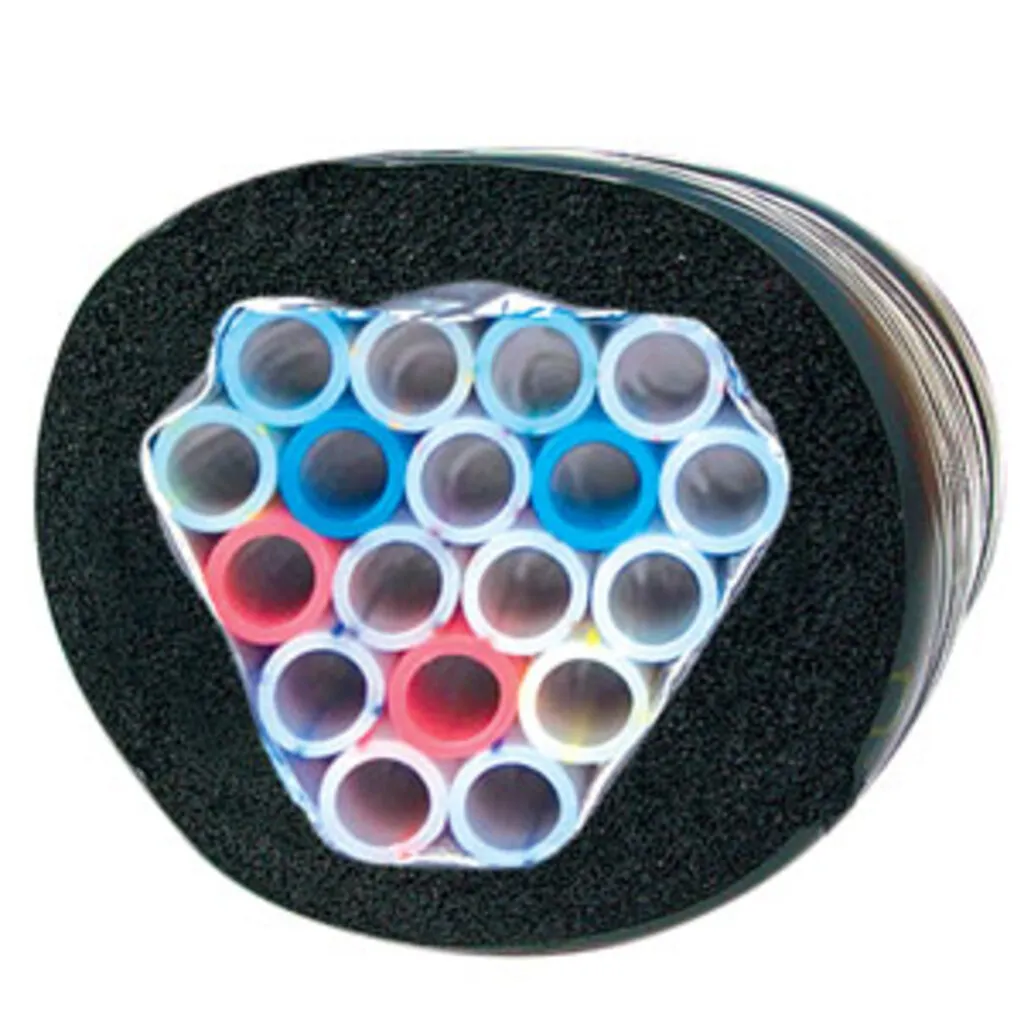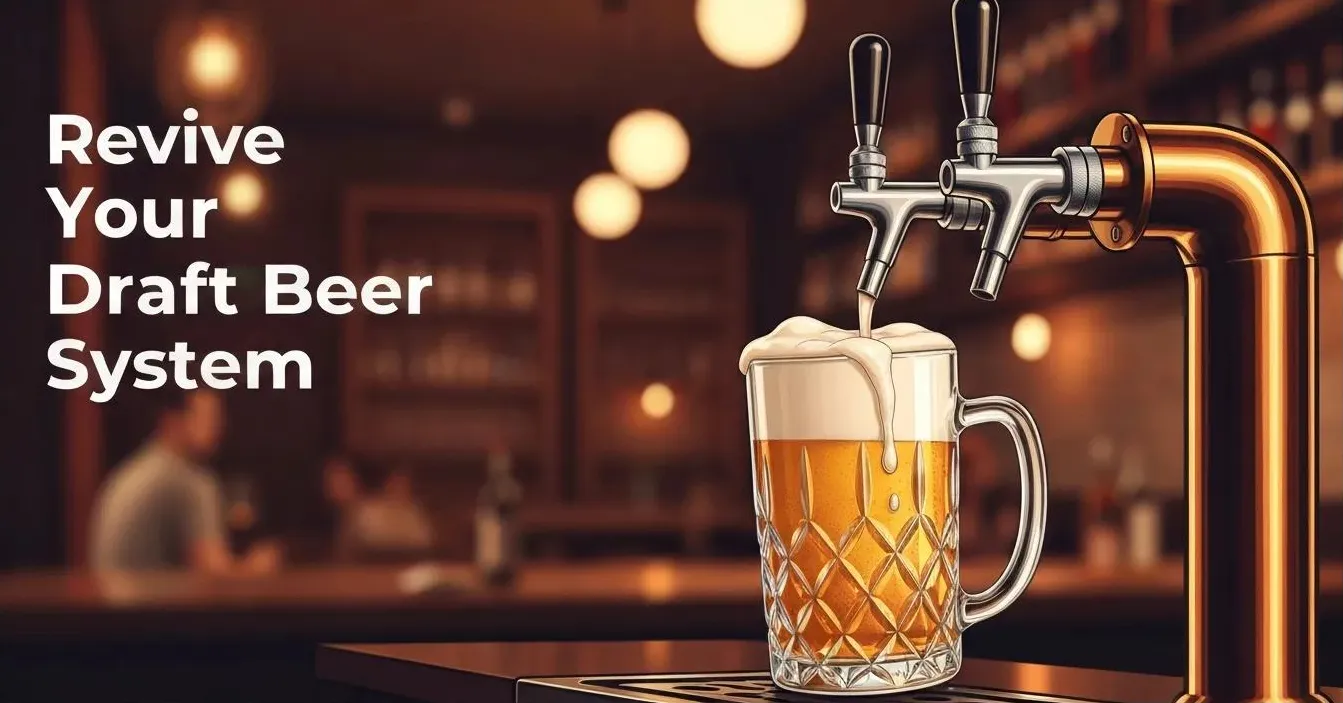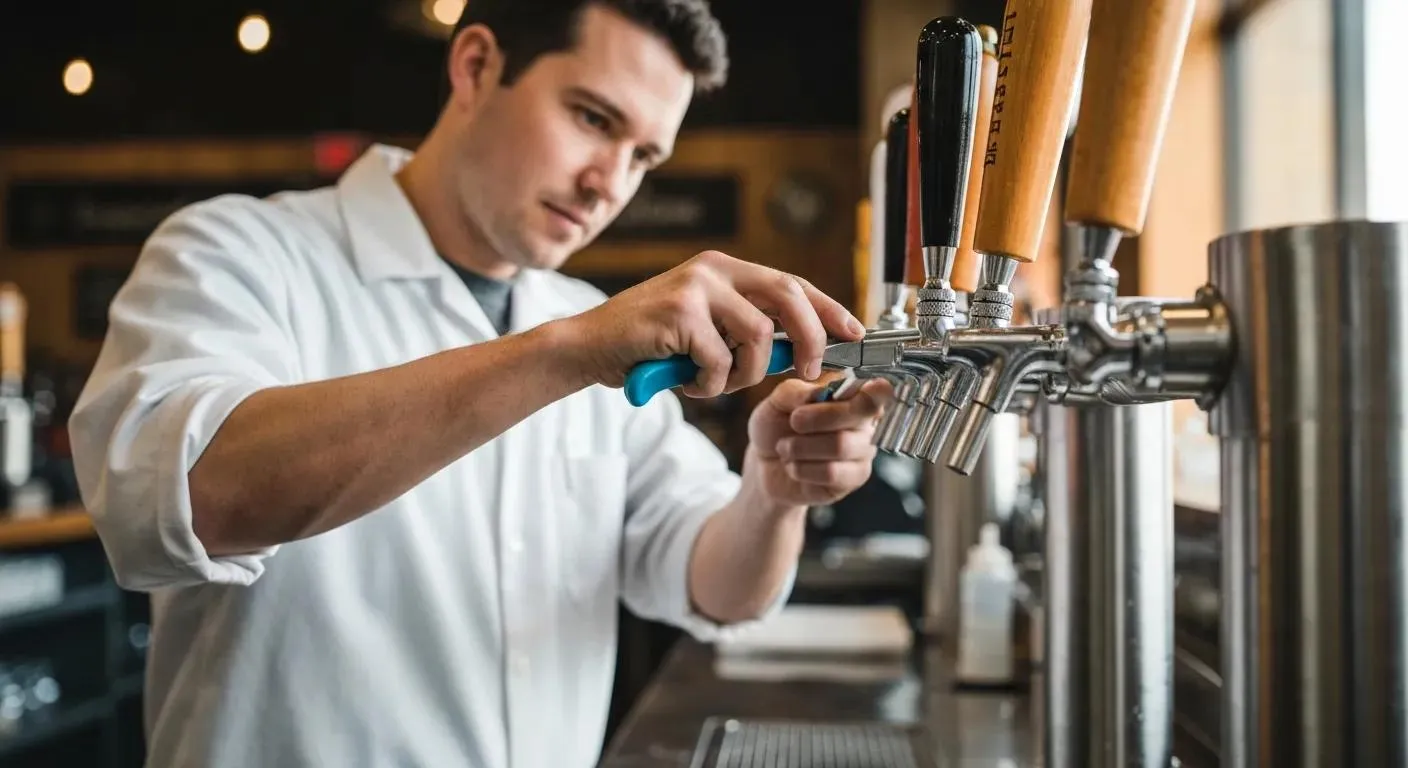Beer Glycol System: Ensuring Optimal Temperature Control in Breweries

Ensuring that draft beer remains cold and refreshing from the keg to the tap requires an effective cooling system. A beer glycol system is a top choice for bars and restaurants that need to serve high-quality, consistently chilled beer. Glycol chillers are essential components for efficient cooling in these systems. The glycol draft chiller system plays a crucial role in maintaining cold beer temperatures in long-draw systems, ensuring the beer stays within the optimal temperature range over significant distances. This system uses a separate chiller that combines propylene glycol with water, allowing beer to be moved over long distances while maintaining a steady cold temperature.
Glycol beer systems are particularly useful for establishments with long-draw setups—typically needing to run over 25 feet. This capability ensures that every glass of beer reaches the customer at the optimal temperature. Businesses seeking to provide the best possible beer experience will find these systems invaluable for their consistent cooling performance and reliability.

Key Takeaways
- Beer glycol systems keep beer cold from keg to tap.
- Ideal for long-draw setups, typically over 25 feet.
- Ensures consistent cooling performance.
Understanding Beer Glycol Systems
Beer glycol systems are essential for maintaining the right temperature of draft beer from the keg to the tap. Trunk lines connect the walk-in cooler to the beer tower, consisting of multiple beer lines bundled with glycol refrigeration lines to cooled draft beer systems to maintain optimal temperature throughout the process. These systems use a mixture of glycol and water to ensure the beer stays cold throughout the dispensing process.

Fundamentals of Glycol Cooling
Glycol is a type of antifreeze that, when mixed with water, creates a cooling agent. This mixture is called a glycol bath. The glycol bath is essential for temperature control in draft beer systems, ensuring that the beer remains consistently cold. The glycol and water mixture typically has a ratio of 35% to 40% glycol.
The glycol chiller plays a crucial role in the system. It cools the glycol mixture to a specific temperature, which is then circulated through glycol lines. These lines run parallel to the beer lines in an insulated package called the glycol trunk line. This setup ensures that beer maintains the ideal temperature as it travels from the keg to the tap.
Components of a Glycol Beer System
A complete glycol beer system includes two glycol chillers and several key components. The glycol chiller or refrigeration unit contains a compressor that cools the glycol mixture. The mixture is stored in a glycol reservoir and pumped through the cooling system by a glycol power pack. The glycol bath circulates through cooling lines that run alongside the beer lines.
The combined glycol and beer lines are insulated together to minimize any temperature loss. This insulated bundle, known as the glycol trunk line, keeps both the beer and the glycol mixture cold. Additionally, components like the glycol bath and the glycol power pack are crucial for maintaining consistent temperature control.

For more detailed information, you can visit this guide on glycol beer cooling systems or check out the essentials of glycol cooling systems for craft breweries.
Installation and Setup
Installing a full glycol draft beer system requires carefully setting up the glycol chiller system and preparing the draft beer tower and lines. A walk-in cooler is essential for storing beer kegs and maintaining the temperature during transportation from the cooler to the dispensing point, especially in long-draw setups. Each part is important for keeping the beer cold and ready for serving.
Building the Glycol Chiller System
A crucial step in the installation is building the glycol chiller system. First, choose a suitable location for the chiller, ensuring it has enough ventilation. A glycol cooling system works best when placed in a cool and dry area.
Connect the glycol chiller to the power supply and fill it with a mixture of water and propylene glycol. It's essential to use propylene glycol because it is non-toxic and food-grade.
Next, install the glycol piping. Run insulated beer lines from the chiller to the draft beer tower. Insulation ensures that beer stays cold from keg to tap. Secure the lines to prevent leaks and wrap them in a protective layer to maintain proper temperature throughout.
Preparing the Draft Beer Tower and Lines
After setting up the chiller, focus on preparing the draft beer tower and beer lines. Start by mounting the draft beer tower on the bartop. Make sure the tower is easily accessible for cleaning and maintenance.
Attach the trunk line, which contains the insulated beer lines and the glycol line, to the tower. The trunk line should be carefully secured to keep the beer lines from getting tangled or damaged. Make sure to balance the system accordingly.
Connect each beer line to its respective keg using the proper fittings. Use a beer walk-in cooler at the right temperature of 38 degrees, and ensure all clamps and seals are tight to avoid leaks. Finally, test the system by running beer through the lines and adjusting the settings on the chiller for optimal cooling.
Maintaining Optimal Performance
Maintaining optimal performance in a beer glycol system is crucial for ensuring quality and consistency. Regular maintenance and troubleshooting play an essential role, as does achieving consistent beer quality through maintaining an optimal temperature and clean equipment.
Routine Maintenance and Troubleshooting
Routine maintenance is key to keeping glycol systems functioning efficiently. Regular maintenance can prevent issues before they arise. Replacing glycol every other year, and flushing the system are essential tasks. The pumps and motor should also be checked regularly for signs of wear and tear.
Troubleshooting helps identify and fix any issues that may affect performance. Common problems include temperature fluctuations and foaming. If the system is not maintaining a consistent temperature, it could be due to clogged glycol lines or an inefficient refrigeration unit. In such cases, inspecting and cleaning the lines or repairing the refrigeration unit might be necessary.
Maintenance Checklist
- Clean trunklines regularly
- Inspect pumps and motor
- Check glycol levels weekly
- Flush system every other year
Achieving Consistent Beer Quality
To achieve consistent beer quality, maintaining the right temperature is critical. The ideal temperature for serving cold beer is around 38°F. If the temperature is too high, it can lead to excessive foaming, while too-low temperatures can freeze the beer lines.
Monitoring temperature closely ensures that the beer remains at the optimal temperature. Keeping the cooling trunk lines very clean and free of debris can prevent clogging, which can affect cooling efficiency. Proper insulation of the trunkline also ensures that both the beer lines and glycol lines are kept cold.
Tips for Consistency
- Set glycol mixture to maintain 38°F
- Regularly calibrate temperature sensors
- Insulate the trunkline to prevent heat gain
Following these practices helps maintain a high-quality draft beer system that reliably serves cold, consistent beer.
Dispensing and Draft Beer System Components
Understanding the various components of draft beer systems and their roles is essential for effective draft beer dispensing. These systems include parts ranging from the tap all the way to the beer tower, each playing a crucial role.
Tapping into the Art of Draft Beer Dispensing
The process of dispensing beer starts at the keg. The keg contains the beer and is connected to a keg coupler. The coupler attaches to the trunkline and eventually the tap.
A primary regulator controls the gas pressure from the tank and ensures it is consistent. From here, the beer travels through the trunkline, where it remains chilled till it reaches the faucet. This helps avoid issues like foam or changes in beer temperature.
Key Elements of the Dispensing System
Different components make up a dispensing system. A critical piece is the beer tower or draft tower, which holds one or more faucets. These towers can be found in bars, restaurants, and breweries. The faucet or tap handle lets the beer flow into the glass through controlled pours.
A glycol-cooled draft beer system ensures beer remains cold during its journey, even over long distances. The glycol cooling system system uses a mixture of water and glycol cooled by a chiller system, then circulated through copper or insulated piping.
A second regulator or secondary regulator often ensures the pressure remains consistent as the beer moves through different parts of the system. Piping connecting these components needs to be clean and free from contaminants to prevent off-flavors.
Other vital parts include the long draw system, the gas blender, which mixes CO2 and nitrogen for nitrogenated beers, and the tap handle that servers use to pour the beer. Ensuring these components are maintained improves the beer dispensing experience and reduces pour cost. Regular cleaning of the beer lines and dispensing apparatus is key to quality control.
Frequently Asked Questions
A glycol beer system keeps beer consistently cool from the keg to the tap. This section answers common questions about how these systems work, their costs, components, required maintenance, optimal operating temperatures, and troubleshooting tips.
How does a glycol chiller enhance a draft beer system?
A glycol chiller enhances a draft beer system by maintaining a constant, optimal temperature. It circulates a mix of glycol and water through cooling lines that run alongside the beer lines, ensuring the beer stays cold from the keg to the tap. This consistency improves the quality of the beer served.
What factors determine the cost of installing a glycol beer system?
Several factors influence the cost of installing a glycol beer chiller system. These include the length of the beer lines, the type and size of the glycol chiller, and additional features such as insulation. Installation labor and maintenance needs also contribute to the overall cost.
What are the typical components included in a glycol beer system kit?
A typical glycol beer system kit includes a glycol chiller or power pack, glycol bath, beer lines, and a trunk line. The trunk line houses both glycol and beer lines in an insulated package to prevent heat gain, ensuring consistent cooling.
What maintenance is required for glycol beer systems to operate effectively?
To operate effectively, a glycol beer system requires regular cleaning of the beer lines and glycol bath. The glycol mixture levels should be checked and adjusted as needed. Periodic inspections of equipment, the glycol chiller and the power pack are also essential to ensure optimal performance.
At what temperature should a glycol system typically be operated for optimal beer dispensing?
A glycol system should typically be operated at around 28°F (-2°C) for optimal beer dispensing. This temperature keeps the beer cold but prevents it from freezing. Maintaining this temperature ensures the beer remains fresh and tastes as intended when served.
What are the common troubleshooting steps for glycol beer system issues?
Common troubleshooting steps include checking the glycol levels, inspecting for leaks in the beer or glycol lines, and ensuring the power pack is functioning correctly. If the beer is too warm, verify that the chiller is set to the correct temperature. Cleaning the lines can also resolve many performance issues.
Summary
A beer glycol system is critical for maintaining the perfect temperature of beer from the keg to the tap. It keeps beer cold and consistent, ensuring that every pour meets quality standards.
These systems use a mix of glycol and water, which is circulated through tubes running alongside the bar and beer lines. This setup helps maintain the beer's temperature, preventing any loss of flavor or consistency during dispensing.
Beer and glycol cooling systems are especially useful for bars and breweries with longer beer lines, typically over 25 feet. This is because shorter lines often don’t require this level of cooling.
Key components of a glycol system include:
- Glycol Chiller
- Glycol and Water Mixture
- Insulated Tubes
The glycol chiller unit cools the glycol mixture before it is circulated through the lines, keeping the beer at an ideal serving temperature. This method surpasses traditional air-cooled systems in both efficiency and reliability.
Benefits:
- Maintains consistent beer temperature
- Enhances beverage quality
- Reduces waste by preventing beer spoilage
By keeping your beer at a consistent temperature, a glycol system improves customer satisfaction. This reliability can also boost the establishment's reputation for serving high-quality drinks at competitive prices.
While the initial cost may be higher than alternatives, the investment often pays off through improved performance and reduced waste, making glycol systems a preferred choice for many establishments.



